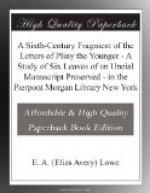[Footnote 21: Specimina Cod.
Lat. Vatic. 1912, pl. 30. See also
H.M. Bannister, Paleografia Musicale
Vaticana 1913, p. 30, No.
109.]
[Footnote 22: See the preface to his edition, p. xi.]
[Footnote 23: For the script of F,
see plates XV and XVI. Bern.
136, s. XIII (Merrill, C.P.
X, p. 18) is a copy of F.]
In Class II the leading manuscript is another Laurentian codex (Mediceus XLVII 36), which contains Books I-IX, xxvi, 8. It was written in the ninth century, at Corvey, whence it was brought to Rome at the beginning of the sixteenth century. It is part of a volume that also once contained our only manuscript of the first part of the Annals of Tacitus.[24] The other chief manuscript of this class is V (Vaticanus Latinus 3864), which has Books I-IV. The script has been variously estimated. I am inclined to the opinion that the book was written somewhere near Tours, perhaps Fleury, in the earlier part of the ninth century.[25] If Ullman is right in seeing a reference to Pliny’s Letters in a notice in a mediaeval catalogue of Corbie,[26] it may be that the codex is a Corbeiensis. But it is also possible that a volume of the Letters at Corbie was twice copied, once at Corvey (M) and once in the neighborhood of Tours (V). At any rate, with the help of V, we may reach farther back than Corvey and Germany for the origin of this class. There are likewise two fragmentary texts, both of brief extent, Monacensis 14641 (olim Emmeramensis) saec. IX, and Leidensis Vossianus 98 saec. IX, the latter partly in Tironian notes. Merrill regards these as bearing “testimony to the existence of the nine-book text in the same geographical region,” namely Germany.[27] There they are to-day, in Germany and Holland, but where they were written is another affair. The Munich fragment is part of a composite volume of which it occupies only a page or two. The script is continental, and may well be that of Regensburg, but it shows marked traces of insular influence, English rather than Irish in character. The work immediately preceding the fragment is in an insular hand, of the kind practised at various continental monasteries, such as Fulda; there are certain notes in the usual continental hand. Evidently the manuscript deserves consideration in the history of the struggle between the insular and the continental hands in Germany.[28] The script of the Leyden fragment, on the other hand, so far as I can judge from a photograph, looks very much like the mid-century Fleury variety




